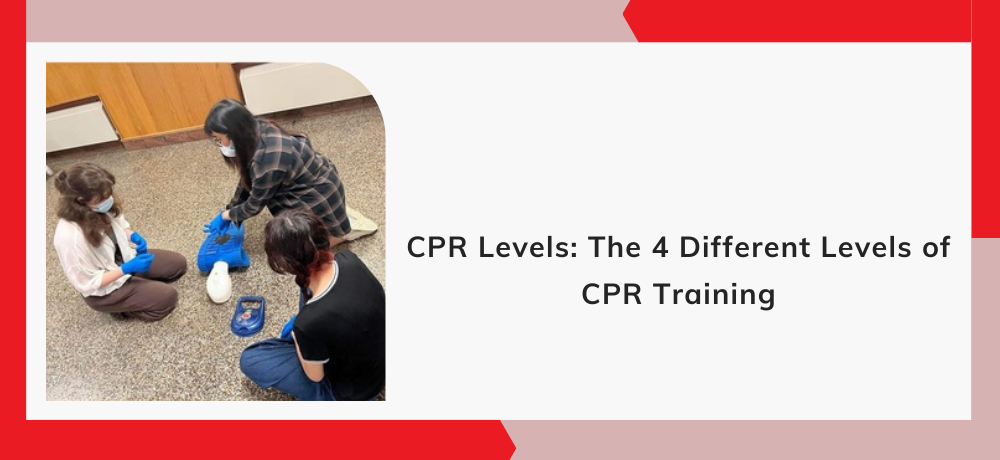CPR Levels: The 4 Different Levels of CPR Training

Cardiopulmonary Resuscitation (CPR) is a life-saving skill that can make a significant difference in emergencies. Whether you're a concerned parent, a healthcare professional, or just an individual who wants to be prepared for unexpected situations, ACT First Aid and Safety Training is here to guide you through the world of CPR training. With a wide range of courses and programs suitable for all ages and educational backgrounds, we're dedicated to helping you acquire the knowledge and skills needed to respond effectively in critical situations. In this comprehensive guide, we'll delve into the four different levels of CPR training to help you understand the options available to you.
Level 1: Basic CPR Training
Understanding the Fundamentals
Basic CPR training, often known as "Hands-Only CPR," serves as an essential foundation for everyone. This level of training focuses on teaching individuals the core techniques required to perform CPR effectively. Here's what you can expect from basic CPR training:
Learning CPR Basics
In this introductory level, participants learn the fundamentals of CPR, such as recognizing the signs of cardiac arrest, calling for help, and performing chest compressions. Basic CPR training is ideal for those who want to gain a basic understanding of life-saving techniques without delving too deep into the medical aspects.
Target Audience
This level is suitable for individuals of all ages, including parents, teachers, caregivers, and anyone interested in acquiring the knowledge to help in emergency situations. It is often the starting point for many who wish to pursue further CPR training.
Certification
Upon completing basic CPR training, participants may receive a certification card that demonstrates their competence in performing Hands-Only CPR. This certification can be a valuable addition to your skillset, offering peace of mind and the ability to assist in life-threatening situations.
Level 2: Standard CPR Training
Comprehensive CPR Skills
Standard CPR training provides a more comprehensive understanding of CPR techniques and is designed for those who require a deeper level of knowledge and expertise.
Expanding CPR Knowledge
In standard CPR training, participants go beyond the basics and gain a more in-depth knowledge of the techniques. This level includes both chest compressions and rescue breaths, enabling responders to provide more comprehensive assistance.
Target Audience
Standard CPR training is recommended for individuals who work in professions where CPR may be required, such as lifeguards, educators, healthcare workers, and safety personnel. It is also valuable for those who wish to be better prepared for emergencies in various settings.
Certification
Successful completion of standard CPR training often leads to a certification that reflects a higher level of expertise. This certification can be vital for professionals in the healthcare and safety industries.
Level 3: Advanced CPR Training
Taking CPR to the Next Level
For individuals who are committed to becoming CPR experts, advanced CPR training offers a comprehensive education in life-saving techniques.
Advanced Techniques
Advanced CPR training covers a wide range of advanced techniques, including CPR for infants and children, two-rescuer CPR, and the use of automated external defibrillators (AEDs). Participants gain a thorough understanding of how to adapt their skills to various scenarios.
Target Audience
This level is primarily intended for healthcare professionals, including doctors, nurses, paramedics, and EMTs, as well as individuals who require a high level of CPR expertise in their workplace.
Certification
Completion of advanced CPR training is typically accompanied by a certification that attests to the participant's advanced skill set. This certification is essential for healthcare practitioners and those working in high-stress emergency environments.
Level 4: Instructor-Level CPR Training
Teaching CPR to Others
Instructor-level CPR training is the highest level of CPR education available and is designed for those who want to train others in life-saving techniques.
Becoming a CPR Instructor
Instructor-level training equips individuals with the knowledge and skills required to teach CPR to others. This includes mastering instructional techniques, understanding different learning styles, and effectively conveying life-saving information.
Target Audience
This level is reserved for individuals who are dedicated to training others in CPR. CPR instructors play a vital role in disseminating life-saving knowledge and skills, making it accessible to a broader audience.
Certification
Upon completing instructor-level CPR training, participants are certified as CPR instructors. This certification allows them to teach CPR courses at various levels, contributing to the spread of essential life-saving skills.
The four different levels of CPR training offer a comprehensive range of skills and knowledge, ensuring that individuals can respond effectively to a wide array of emergency situations. Whether you're a healthcare professional, a teacher, a parent, or simply a concerned citizen, there's a CPR training level suited to your needs and expertise. The importance of CPR training cannot be overstated, as it equips you with the tools to save lives when every second counts.
If you're interested in any of our CPR training programs or have any questions,then contact ACT First Aid and Safety Training. We offer an unmatched variety of courses and programs, created for individuals or groups of all ages and academic levels. Browse our site to learn more, and get in touch if you have any questions. Over the last 5 years we have been certified in various industries with our participants being in different age groups including lifeguarding, schools, corporations and large groups, daycare centers, constructions, clinics, dental clinics, etc.
Get in touch with us today
To learn more about what we do, please click here. To contact us, please click here or call us at (647) 470-8500.